
Neptune in Your Horoscope
The Absorption into something Great
Nebulousness and Impressionability
In horoscope interpretations Neptune loosely indicates the incorporation of something mysterious into a personality. It is mainly concerned with imagination, dreams and extra sensory perception. This is the planet that influences a person's responsiveness to stimuli and gives us all our unique vagueness and individuality. Neptune takes over 60 years to orbit and is thought to be responsible for determining our subconscious choices and their resulting actions. It is significant in Astrology studies as it helps us to account for the wide variation of different personality types and all their individual characteristics. Without its presence horoscopes may be easier to read but they will not be infused with such originality.
Neptune is the most far away planet from our Sun in our Solar System and is thought to be named after Titan God of the Sea. This planet was discovered by mathematical means as it is not visible from Earth. It is primarily composed of Hydrogen, Helium and hydrocarbons and has an ice and rock core similar to Uranus's. Sometimes this planet radiates a bluish tint and this is thought to be because of traces of Methane that have built up around its edge. The atmosphere is extremely cold and windy and storms are common among the weather patterns. Neptune in astrological representations is associated with the creative, expressive and emotional side of our personalities.
Of the very rare myths about Neptune most are about the Greek God Poseidon who became the Roman deity who the planet is named after. Neptune was the brother of Jupiter and Pluto. Following the defeat of their father Saturn the three brothers are believed to have divide the world into three parts, one each. Jupiter took the sky, Pluto asked for the underworld and Neptune gained command over the Sea. Neptune made his presence felt by evoking wild storms and earthquakes when he was angered. He had a quick temper and is depicted as always carrying his trident ready to vent his rage. Neptune was feared and news of his existence was widespread. and so he was naturally highly respected and admired.
The legend of how Neptune chose his bride the water nymph called Amphitrite highlights his influencing insight and inspiration. Legends say that upon her refusal to marry him he was not discouraged and set about devising a plan. He asked his trusted servant the Dolphin to locate her and persuasively plead with her to reconsider Neptune's offer of complete devotion. The Dolphin managed to express upon her how much Neptune loved her and he was successful in marrying her. As a reward to the Dolphin for his loyalty and hard work he was granted immortal life and placed in the heavens. This little mythical tale sums up Neptune's message of perceiving what is not there and making it happen.
Neptune's position and influential power in astrological birth charts can sometimes be sensed rather than known. This planetary zodiac influencer offers insight into a person's way of thinking and how they utilize their thought sequences in order to make their decisions in life. We all have are own way of thinking about things and Neptune is presumed our personality guide in this area. He taps into the subconscious level of our thoughts and gives us the means to discover the effectiveness of our contemplation procedures. It helps us visualize things in an ideal form so we can aim our sights for this imagined perfection. The connection to dreaming from Neptune's appearance ties in with his intention of creating imaginative realities.
Symbolically Neptune is represented by a combined crescent and cross shape bearing the resemblance of Neptune's trident. This is probably one of the most easily identifiable symbols in any astrological writing or interpretation. The down turned crescent is meant to signify human spirit and the cross symbolizes the mind surpassing the matter. This icon reinforces the message of Neptune by reminding us that things that are not acted out and emotionally displayed remain inside. This planet's influential forces are here to teach us how to idealize and dream up ideas to realize our thoughts and put them into some kind of positive and effective action.
Neptune is astrologically ruled by the Western Sun sign of Pisces whose identification is the fish. This is an apt arrangement as Neptune has connections with the Sea and it increases the influencing possiblities in a person's character formation. Pisces is typically known for their deep thought, sensitivity and dreaminess. With these traits alongside Neptune's haze of mystery it is simple to remember that his most prominent communication of guidance with sensory awareness and its advantages. Neptune locations can help give an indication of how in tune people are with their fabled sixth sense. A strong prominence of this orbital body in your natal map can uncover a highly astute individual who follows his or her instincts.
Planet Profile
Mass (kg) 1.02 x 1026
Diameter (km) 49528
Mean density (kg/m3) 1640
Escape velocity (m/s) 23300
Average distance from Sun 30.07 AU (4,498,252,900 km)
Rotation period (length of day in Earth days) 0.67 (19.1 hours)
Revolution period (length of year in Earth days) 60,190 (164.8 Earth years)
Obliquity (tilt of axis degrees) 29.6
Orbit inclination (degrees) 1.77
Orbit eccentricity (deviation from circular) 0.009
Mean temperature (K) 48
Visual geometric albedo (reflectivity) 0.51
Atmospheric components
74% hydrogen,
25% helium,
1% methane (at depth)
Rings
Rings are narrow, and contain
concentrations of particles
called ring arcs.
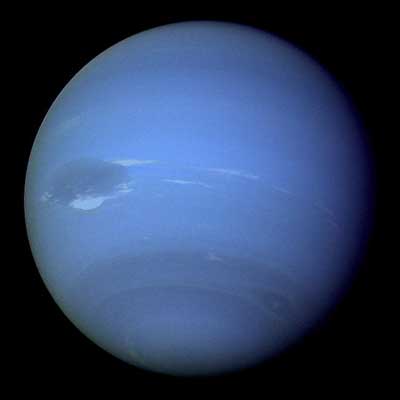 Full Disk Neptune
Full Disk Neptune
On its approach to Neptune in August 1989, Voyager 2 captured this image of the fourth and outermost of the giant gas planets. This image shows two of the four oval cloud features tracked by the cameras. The large dark oval near the left edge revolves around Neptune every 18 hours. The bright clouds immediately to the south and east of this oval substantially change their appearance in periods as short as 4 hours. The second dark spot, at lower right edge, revolves around Neptune every 16 hours.
Weather Forecast
The location of clouds in Neptune's atmosphere was used for testing the accuracy of Neptunian weather forecasts to aid in the selection of targets for the narrow-angle camera. Three of the four targeted features are visible here, and all three are close to their predicted locations. The Great Dark Spot with its bright white companion is slightly to the left of center. The small vivid Scooter is below and to the left, and Dark Spot 2 with its shiny core is below Scooter. Strong eastward winds, up to 644 kph (400 mph), caused the smaller dark spot to overtake and pass the larger one every five days.
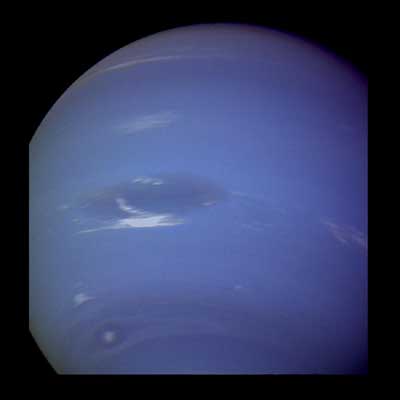
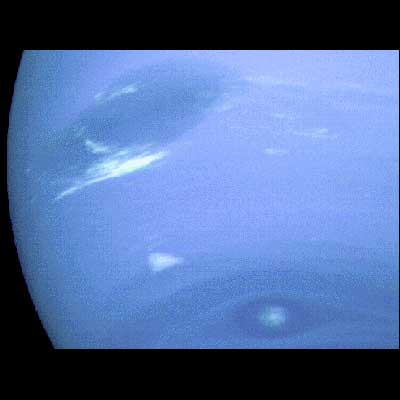 Scooter with Spots
Scooter with Spots
The three features visible here are among the most interesting on Neptune. At the top is the Great Dark Spot, accompanied by bright, white clouds that change rapidly with time. Below the dark spot is a bright feature that scientists nicknamed "Scooter." Below Scooter is the Small Dark Spot. All three features move eastward at different velocities, so it is rare that they can all be photographed together.
Cloud Evolution
The bright cirrus-like clouds of Neptune change rapidly, often forming and dissipating over several hours. In this sequence spanning two rotations of Neptune (~36 hours), Voyager 2 observed cloud evolution in the region around the Great Dark Spot. The surprisingly rapid changes, which occurred over the 18 hours separating each panel, show that in this region Neptune's weather is perhaps as dynamic and variable as that of the Earth's. However, the scale is immense by our standards because the Earth and the Great Dark Spot are similar in size.
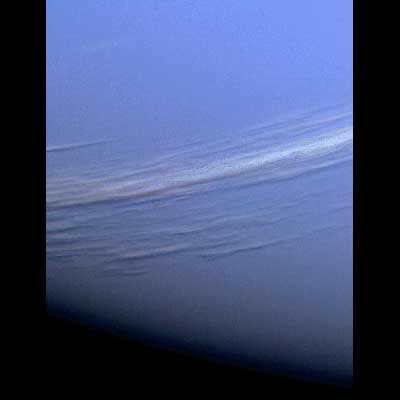 Bright Cloud Streaks
Bright Cloud Streaks
This Voyager 2 high-resolution color image, taken 2 hours before closest approach, provides obvious evidence of vertical relief in Neptune's bright cloud streaks. These clouds were observed at 29 degrees North latitude near Neptune's east terminator. The linear clouds are stretched approximately along lines of constant latitude and the sun is toward the upper left. The sides of the clouds facing the sun are brighter than the surrounding cloud deck because they are more directly exposed to the sun. Shadows are visible on the side opposite the sun.
True-Color Image
This Voyager 2 image has been processed to obtain true color balance. The processing allows both the clouds' structure in the dark regions near the pole and the bright clouds east of the Great Dark Spot to be reproduced. These and other features suggest waves are present in the atmosphere and play a large role in the type of clouds that are visible.
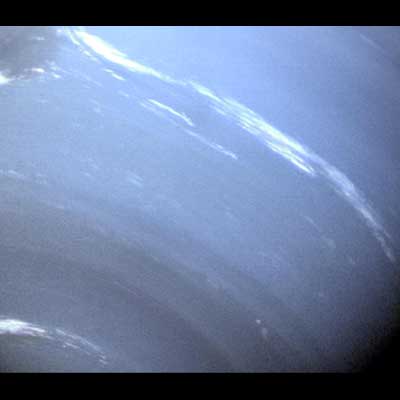
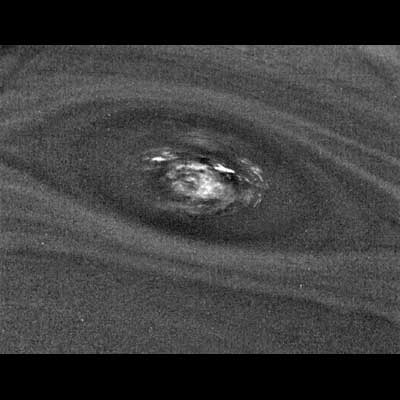 Small Dark Spot
Small Dark Spot
This image was obtained when the infrared spectrograph was mapping Neptune. It is the highest-resolution view of the small dark spot (D2) taken during the flyby. Banding around D2 indicates unseen strong winds, while structures within the dark spot suggest both active upwelling of clouds and rotation about the center. The V-shaped structure near the right edge of the bright area indicates that the spot rotates clockwise.
The Great Dark Spot
Feathery white clouds fill the boundary between the dark and light blue regions on the Great Dark Spot. The spiral shape of both the dark boundary and the white cirrus suggests a storm system rotating counterclockwise. Periodic small-scale patterns in the white cloud, possibly waves, are short-lived and do not persist from one Neptunian rotation to the next. Depicted here is the last face-on view of the Great Dark Spot that Voyager 2 made with its narrow-angle camera. The image was shuttered 45 hours before closest approach.
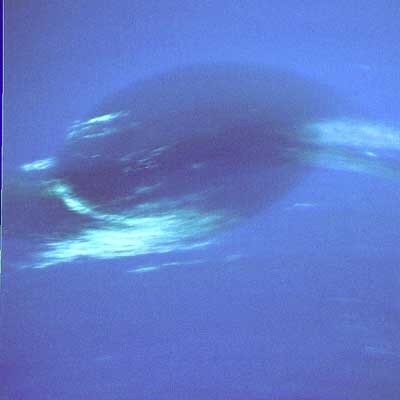
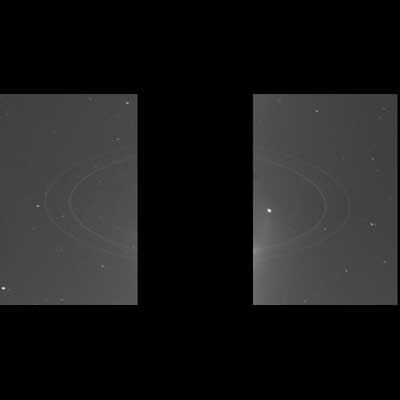 Faint Rings
Faint Rings
The rings around Neptune are so faint that when Voyager's cameras captured this image, the brightness of Neptune nearly made them impossible to detect. The black box in the center of the image is where Neptune was blocked out because no detail was visible given the long exposure time required to capture the almost invisible rings. The bright glow at the edges of the black box is some of the light reflected from Neptune. Two sharp rings are visible, Leverrier and Adams, and one faint ring, Galle, is barely visible inside them.
Strange-Shaped Moon
The irregular shape of Proteus suggests that it has been cold and rigid throughout its history and subject to significant impact cratering. The satellite has an average radius of about 200 km (120 mi) and is uniformly dark with an albedo of about 6%. This image was taken from a range of 870,000 km (540,000 mi).

Tiny Dark Moon
With an average radius of only 200 km (120 mi), this tiny half-illuminated satellite appears spectrally gray with an albedo of 6%. Hints of crater-like forms and groove-like lineations can be seen. The graininess of the image is caused by the short exposure necessary to avoid significant smear.
Captured Moon
The pink hue of Neptune's largest moon, Triton, is thought to result from a slowly evaporating layer of nitrogen ice. Triton is an oddity among moons in that its orbit is highly tilted to the plane of Neptune's equator, and it is in a retrograde orbit. These facts have led scientists to believe that Triton formed independently of Neptune and was later captured by Neptune's gravity.
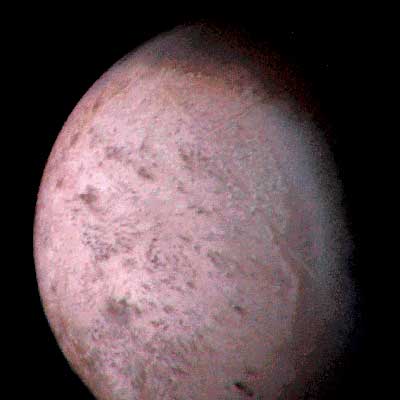
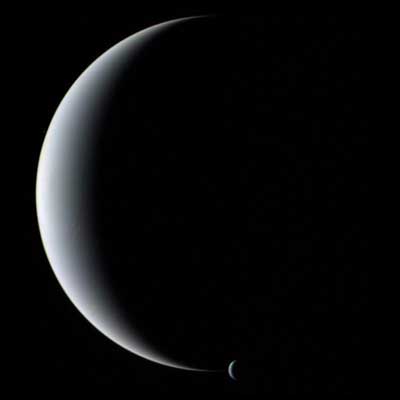 Parting Look
Parting Look
Voyager 2's parting look back at the Neptune system shows a beautiful dual-crescent view of Neptune and its largest moon Triton.
In mythology :
Neptune was the chief of the water deities
Neptune was the chief of the water deities. The symbol of his
power was the trident, or spear with three points, with which he
used to shatter rocks, to call forth or subdue storms, to shake
the shores, and the like. He created the horse, and was the
patron of horse races. His own horses had brazen hoofs and
golden manes. They drew his chariot over the sea, which became
smooth before him, while the monsters of the deep gambolled about
his path.
Comments: Neptune Meaning - The Seven Spirit